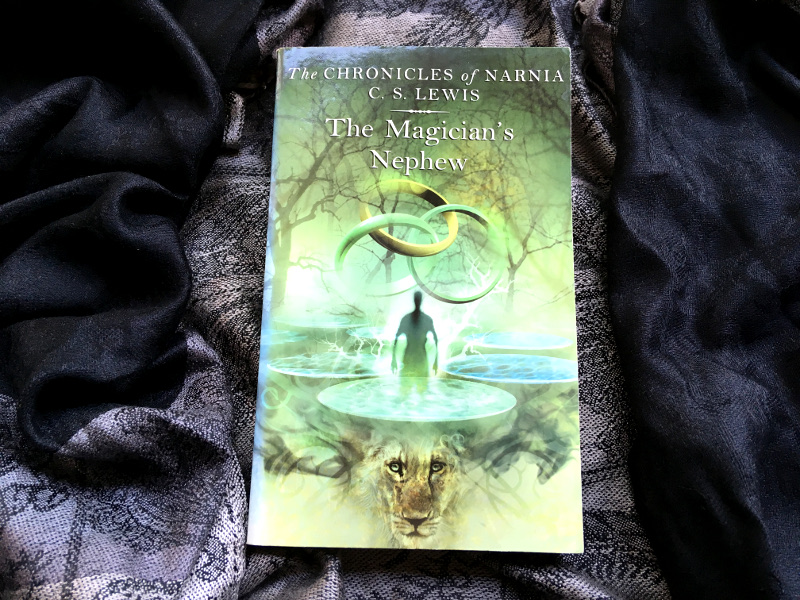The Magician's Nephew by C.S. Lewis
Tuesday, June 26, 2018
This must be the year of the reread. I swear I read new books sometimes! But recently I’ve enjoyed digging into old favorites, seeing how they’ve shaped me as a writer, and trying to figure out what made them so good. While I chip away at longer books and wait to get others from the library, I'm starting a new series on The Chronicles of Narnia. In today’s post, I fangirl over The Magician’s Nephew and try to explain why the book is so enchanting that I’ve read it three or four times.
Description
The year is 1900 and Polly Plummer lives in a London townhouse. When Digory Kirke moves in next door, they become playmates for all sorts of adventures. One day, while exploring the shared attic crawlspace of their row of townhouses, the two accidentally open a door to Digory’s uncle’s forbidden laboratory. Uncle Andrew tricks them into being the test subjects for his experiment. They discover other worlds, some growing old and some just being created. They encounter ominous poetry, a powerful villain, talking animals, forbidden fruit, kings, queens, mountains, gardens, unlikely trees, and, of course, magic.The Magician’s Nephew is a children’s chapter book by C.S. Lewis, first published in 1955. In chronological order, it is the first book in his Chronicles of Narnia series, but it was originally published sixth, after The Horse and His Boy and before The Last Battle.
This time I listened to the unabridged audiobook version from HarperCollins read by Kenneth Branagh, which is excellent. I also have a 2002 paperback copy from HarperTrophy (pictured above).
Why I Love The Magician’s Nephew
- It’s easy to read and understand. The words don’t draw too much attention to themselves. Instead they pull us into the story.
- It has a great balance of show v. tell. Lewis shows us just the right details to paint a vivid mental image, and then tells us interesting pieces of information that give a wider view of the settings, characters, etc.
- It’s concise. Everything has a purpose, whether that’s to describe characters and settings, create foreshadowing, or further plot and theme. Lewis knows what’s important and what’s not—and he leaves out the unimportant stuff.
- It’s funny. There are hilarious one-liners, comic situations, and irony. Even some of the book’s themes are introduced through absurdities that left me chuckling.
- The magic doesn’t feel mechanical. You will neither see characters calling out their spells like moves in a bad comic book fight nor conveniently overcoming obstacles with newfound skills. Lewis uses magic in this story mainly to give a sense of wonder, rather than to solve plot problems. In fact, magic creates a lot more problems than it solves.
- There’s a rich and expansive story world. This book involves multiple other worlds, plus late Victorian London and even a “wood between worlds.” While none of these settings are explored in great depth, the details of the children’s visits are enough to create a vivid mental snapshot of each place.
- It creates that sense of wonder. This isn’t just about the magic, the setting, or even the wonders of childhood. It’s about more than theme, story, and narrator voice. It’s all of those things woven together. The whole is greater than the sum of its parts.
- There’s fairly equal representation of the sexes. While Digory is the protagonist of the story, Polly goes on the adventure too. There’s even a villain of each sex. Overall the story is pretty balanced, and that helps it to appeal to both boys and girls.
Weakness
Short books have less room for character complexity and development. If sympathetic villains and lots of complex characters are on your must-have list, you might want to consider looking at longer books written for older children and adults.In this book, most characters get one or two defining personality traits, and that’s about it. Digory is a little more complex than other characters because he’s the protagonist, but Lewis plays to stereotypes. His method for creating complexity is not to combine opposing characteristics into one character, but to give them to different characters and have those characters interact.
This includes gender stereotypes. Polly stands in for all little girls of the time, so she’s pretty stereotypical. Likewise, Digory stands in for all little boys, and any complexity he has stems from worrying about his mother. They’re both imaginative and curious, and their intelligence is about equal. But Digory is more likely to act out and Polly is more likely to do what she thinks they’re supposed to do. When Uncle Andrew tricks Polly into being his guinea pig, Digory has to go and bring her back. If these sorts of things bother you, good luck finding older children’s books that you'll like.
Bottom line
I freaking love this book. It’s one of the few books from my childhood that I read over and over again. If I sold everything and moved into a tiny house, this is one of the first books I would replace with an ebook (as opposed to just getting rid of it entirely). I recommend this book for imaginative children and adults alike. Kids as young as six might enjoy having it read to them, but to read independently it’s more like a book for ages eight and up. I rate The Magician’s Nephew 7/7 twisty mustaches and look forward to rereading the rest of The Chronicles of Narnia.
Have you read The Magician’s Nephew? What did you think of it? Leave a comment below or my hairless ghost lemur will haunt your dreams.




0 comments